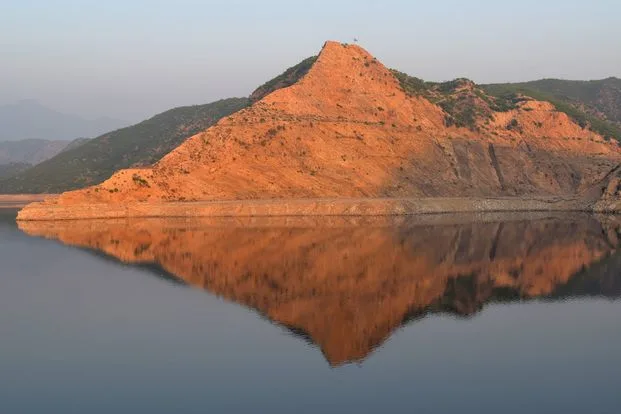- Advertisement -
SWABI, Aug 01 (APP):The Kondal dam in Swabi district on Thursday experienced a surge of visitors following recent heavy rains that have transformed the area into serenity.
On a cloudy day marked by cooler temperatures following last night’s heavy downpour, Jalal Khan and his family enjoyed a daylong excursion to the dam, rejoicing in the refreshing weather in Kondal dam along with other tourists who arrived in droves.
Khan, a resident of Nowshera district expressed his delight at finally making the trip he had eagerly anticipated to celebrate his son’s birthday amid great fun and laughter.
“We waited for a day like this to escape the scorching heat and bask in the natural beauty of Kondal Dam to make my son’s birthday memorable,” he told APP. Dressed in Salwar Kameez, Jalal’s family savored traditional Peshawari dishes, including Rich Polo and Chappli Kabab, while their children played nearby.
Kondal Dam, standing 48 meters high and boasting a water reservoir capacity of 11,755 acre-feet, has become a popular destination for both tourists and adventure sports enthusiasts and if properly developed can become a great centre for eco-tourists. The tourists also enjoyed horse riding and boating amid a cold breeze that elevated its appeal, filling the area with visitors eager to experience its scenic allure.
“The weather here is enchanting,” remarked Nabeel Khan, Jalal’s son, as he danced to the famous national song “Dil Dil Pakistan.” He praised Pakistan’s natural beauty and emphasized the potential for small dams in Khyber Pakhtunkhwa to attract more tourists if developed with modern amenities.
Khan said Tanda dam in Kohat, Kondal of Swabi , Jalozai dam in Nowshera carried huge potential of promoting ecotourism in KP subject to develop tourism related infrastructure.
Covering an area of 405 hectares, Tanda dam in Kohat is another most suitable dam for promotion of ecotourism and water sports having a big lake with water storage capacity of 65,000 acres feet.
Tourists and residents of Kohat, Hangu, Kurram and Peshawar districts besides nearby towns and villages of Jurma and Shahpur would largely benefit. Tanda dam is a protected site for conservation and utilisation of wetlands and a home to migratory birds including Siberian cranes and ducks.
Pakistan has more than 24 big and small rivers including five in Punjab, four in Sindh, eight in Khyber Pakhtunkhwa and seven in Balochistan with numerous suitable natural sites for construction of small, medium and big dams to promote tourism besides fulfilling the growing water needs of the people.
Chanab, Jhelum, Ravi, Sutlaj and Beas in Punjab, Kabul, Swat, Punjkora, Kunhar, Bara, Kurram, Haroo, Gomal, Chitral in KP, Nari, Bolan, Pishin, Lara, Mula, Hub, Zhob, Porali, Hangol, Rakshan, Dasht in Balochistan and four rivers in Sindh province are most suited for dams.
Despite tourism, these dams’ sites were also useful to fulfill the country’s water and agriculture needs. Inspite of having enormous water potential, Pakistan is gradually moving towards water-scared country where most of living creatures including humans, animals, plants, wildlife, mammals and reptiles are facing the looming threats of water scarcity.
The National Water Policy (NWP) 2018 has revealed that Pakistan was heading towards a situation of water shortage due to lack of water reservoirs, which may lead to food insecurity for all living creatures in next few years if dams were noted constructed.
The policy disclosed that per capita surface water availability has significantly declined from 5,260 cubic meters per year in 1951 to around 1,000 cubic meters in 2016. This quantity is likely to further drop to 860 cubic meters by 2025, marking Pakistan’s transition from a water stressed country to a water scarce country.
The groundwater situation is expected to further drop in the country mostly in Punjab and Sindh where one million tube-wells are currently pumping about 55 million acres feet (MAF) of underground water for irrigation, which is 20pc more than that available from canals.
Dr Zilakat Malik, former Chairman Economics Department, University of Peshawar told APP that water resources were inextricably linked with climate and the impending climate change scenario has posed serious implications for the country’s water resources.
The changing and unpredictable precipitation patterns caused by climate change have serious consequences, including flash floods in north and increasingly prolonged droughts in the south if dams were not constructed on priority basis, he added.
With glaciers retreat, he said more glacial lakes will form, increasing the risk of Glacial Lake Outburst Floods (GLOF) that is already becoming increasingly common and hazardous in northern parts of the country.
“The small dams are only remedy to store flood and rainy water mostly in arid areas like Karak, Bannu, Lakki Marwat, Kohat, DI Khan, DG Khan, Bhakkar, Bahawalpur, Multan, Tharparkar besides merged areas of erstwhile Fata to bring maximum dry land under cultivation and minimize impact of natural disasters,” he said.
He said Pakistan receives around 142MAF water annually through western rivers of which 104MAF is used for irrigation purposes. Similarly, approximately 40MAF water is obtained from normal rainfall and 40pc through underground water per year.
Dr Malik said that Pakistan was the only country with diversity in weather, rainfalls, landscape, forests, climate, and mountains with capacity to construct 1000 small dams.
Terming small dams as a backbone of agriculture in developing countries like Pakistan, he said that we can achieve self-sufficiency in food through establishing a network of small dams.
He said that small dams were being preferred mostly in developing countries like SAARC for irrigation of agriculture and drinking water because it is cost & time efficient and do not require foreign investment compared to big dams, adding small dams can easily be constructed in two to three years while big dams mostly require 10 to 15 years.
The Directorate of Small Dams KP told APP that 56 small dams at a cost of Rs26.7 billion having a storage capacity of 281,410 acre feet were completed in KP, adding that 30 more small dams would be completed soon at a cost of Rs43.6 billion.
As many as 18 dam projects were settled and 12 for tribal districts besides 14 small dam projects were in final stages that would be completed in the current year.
These include Khattak Banda Dam in Kohat, Makh Banda and Latambar dams in Karak, Jaroba Dam in Nowshera and Pezu Dam in Lakki Marwat. Similarly, 14 small dams could store 46,400 acres feet of water and would irrigate 34,000 acres of land.
The experts said that Pakistan’s economy was mainly based on agriculture requiring water and construction of small dams was inevitable to meet the growing food requirements of its people.

